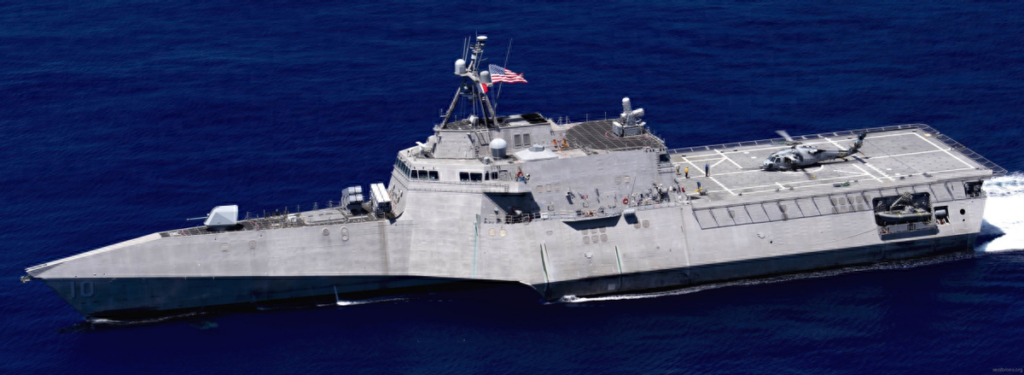U.S. Navy LCS-10 “Gabrielle Giffords” Intrudes Near Ren’ai Reef, Monitored Closely by Chinese PLA’s Southern Theater Command
In a recent development, the U.S. Navy’s littoral combat ship LCS-10 “Gabrielle Giffords” illegally entered the waters near China’s Ren’ai Reef, prompting the Chinese People’s Liberation Army (PLA) Southern Theater Command to mobilize naval forces for continuous monitoring and alert. Initially, it was widely believed that the U.S. Navy had gained the upper hand in this incident.

This belief stemmed from the fact that it was the first time a U.S. naval vessel had approached so close to Ren’ai Reef, a move seen as an overt show of support for the Philippines.
However, as more information surfaced, it became apparent that the perceived advantage of the U.S. Navy was illusory. The strategic initiative around Ren’ai Reef had long been in the hands of the PLA.
Satellite imagery revealed a significant change in the Chinese response to the intrusion near Ren’ai Reef. Unlike previous instances where PLA ships monitoring U.S. naval movements in the South China Sea were mainly Type 054A frigates or coast guard vessels, this time, the “Gabrielle Giffords” was greeted by a Type 052D destroyer.
This is not a trivial distinction. Despite the rapid expansion phase often referred to as “dropping dumplings” in the Chinese Navy’s development, the training cycle for ship crew cannot be expedited through financial investment alone. This has frequently led to a situation where ships are waiting for crew, significantly limiting the construction pace of the Type 052D destroyers. As a result, the PLA currently has only 25 active Type 052D destroyers. After being divided among the Northern, Eastern, and Southern Theaters, only nine remain in the South.
Admittedly, nine destroyers is not a small number. However, as the mainstay of the PLA Navy’s surface fleet, the Type 052D has a wide array of tasks. After accounting for routine training, maintenance, and periodic deployments with the Shandong aircraft carrier to the Western Pacific, there is little time left for the Type 052D to be stationed permanently in the South China Sea to counter U.S. provocations. Monitoring and alert duties are typically handed over to the more numerous Type 054A frigates and coast guard vessels.
This time was different. The presence of the Type 052D destroyer monitoring the “Gabrielle Giffords” was likely deployed from the port on Meiji Reef.
This implies that the PLA had already stationed a Type 052D destroyer at Meiji Reef even before the U.S. Navy reached Ren’ai Reef. This development suggests that China may be planning to change its response strategy to incidents at Ren’ai Reef.
Simply put, in response to continuous provocations by the U.S. and the Philippines at Ren’ai Reef, taking advantage of their geographical proximity, China might soon upgrade Meiji Reef into a naval base permanently hosting various combat units, including aviation and surface fleet troops.
Aside from its small garrison size and lack of logistic support for larger ships, Meiji Reef’s current functions are already similar to a formal naval base. Compared to some of the U.S. overseas bases, Meiji Reef, as a forward base, is quite well-equipped. With further infrastructure development, the reef could accommodate an aviation squadron and large surface vessels like the Type 052D destroyer for long-term deployment.
Additionally, stationing the Type 052D at Meiji Reef would help counter provocations from the Philippines and the U.S. regarding Ren’ai Reef. Although the PLA Navy has many Type 054A frigates to handle various issues created by the U.S., the Philippines, and other countries in the South China Sea, these ships have a speed limitation of under 30 knots. This makes it difficult for the Type 054A to rapidly move between incident areas and puts them at a disadvantage when facing faster vessels deployed by the Philippine and U.S. forces.
A case in point is the recent intrusion near Ren’ai Reef by LCS-10 “Gabrielle Giffords.” As a member of the Independence-class littoral combat ships, this class has been plagued by serious quality issues, hindering high-speed navigation in sea states above 4. However, due to favorable sea conditions in the South China Sea, the ship was able to reach speeds over 30 knots, using its speed advantage to evade the pursuing Type 054A frigates.
This is why satellite images of Meiji Reef often show the presence of Type 022 missile boats. Their top speed of over 40 knots can compensate for the Type 054A’s speed disadvantage.
However, the size of the Type 022 missile boat limits its ocean-going capabilities and endurance, confining its operations to the vicinity of islands and reefs. To comprehensively deter maritime harassment by the U.S. and the Philippines, the PLA Navy naturally needs a vessel with overall superior performance to the Type 054A, namely the Type 052D destroyer.
Moreover, the limited number of Type 052D destroyers in the Southern Theater Navy is based on the assumption that countering U.S.-Philippine activities near Meiji Reef is an additional task. If Meiji Reef is developed into a base, the Type 052D can conduct long-term training integrated with combat operations there. Not only can they complete containment missions against U.S.-Philippine provocations while training, but prolonged maritime standoffs can also effectively improve the crew’s tactical skill training efficiency.
Furthermore, considering the recent acceleration in the commissioning rate of Type 052D destroyers to 3-4 ships per year, the PLA’s talent training system has evidently undergone corresponding reforms for speed and efficiency. In this context, the number of Type 052D destroyers in service is set to rapidly increase in the foreseeable future.
Taking into account that the upgrading of Meiji Reef into a base also requires time, by the time all infrastructure is completed, it’s not just about permanently stationing a Type 052D at Meiji Reef. The Southern Theater Navy might well have the capability to maintain a small task force of destroyers and frigates on the island. Compared to the U.S. Navy’s single littoral combat ship permanently stationed in Singapore, the strategic advantage is self-evident.